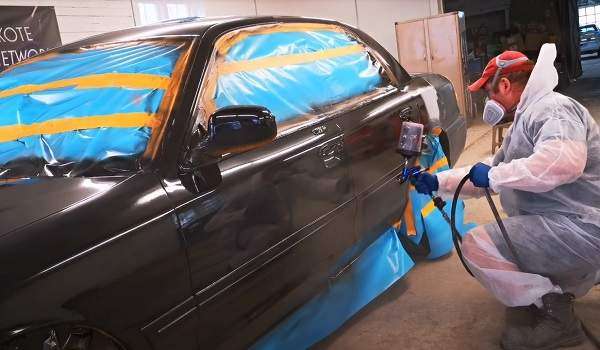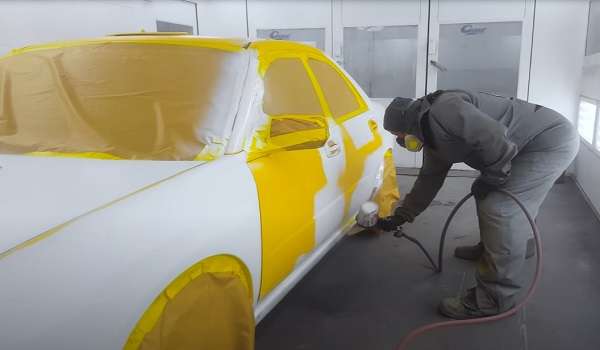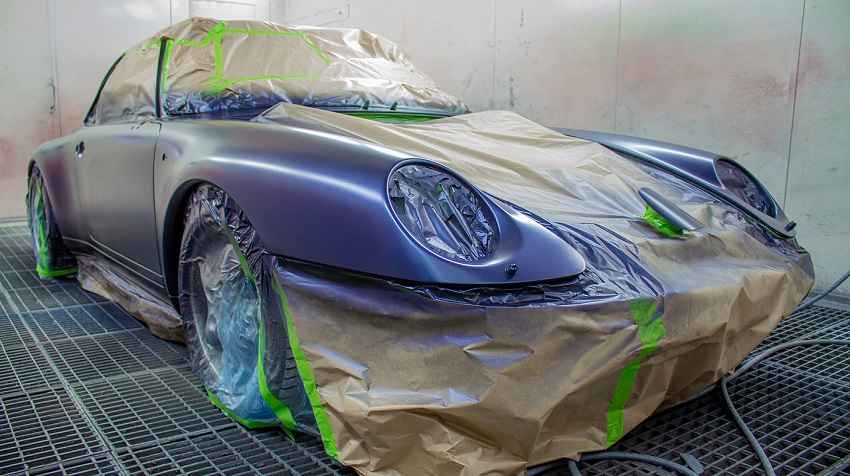The appearance of your vehicle is dependent mainly on the painting of its outer surface. Choosing a suitable method between the single stage vs two stage paint for your vehicle is the key to having the desired finish.
Single-stage paint technique will have your vehicle painted within a short time, leaving your car looking good. The two-stage paint method may take more time than the single-stage paint as it requires time breaks between the base coat and clear coat application.
Both methods are efficient in giving your vehicle an attractive appearance. Reading through this article will give you a better understanding of the two techniques to help you make the right choice for you.
What Is Single Stage Paint?

As the name sounds, single-stage paint involves applying only one coat on the vehicle’s surface. Single-stage paint may seem easy to apply, but it needs skills to achieve the desired results.
To apply, first put a primer on your car’s dents and scratches. Apply the single coating to your satisfaction. You can apply two coats to achieve a denser coat. Single-stage painting has the base and clear coat ingredients combined, unlike the two-stage painting, where each coat is applied individually.
With improved technology, you can apply the 2k single stage paint, which undergoes a chemical reaction resulting in the hardening of the paint. These two-component paints mix to form a highly durable and corrosion-resistant coat.
The two-component paints contain polyisocyanates that chemically react to form a more durable paint. Be keen to apply the mixture quickly before it hardens in the container. Only mix the required volume to avoid wastage.
Don’t apply the shooting gun too close to the surface, as the paint will run. Applying the paint far from the surface will have the paint land on the surface when dry. Painting calls for good mastery of the art of spraying at standard angles and distances.
Advantages of Single Stage Paint
Single-stage paint works the best if you know how to apply it skillfully. This technique comes with several advantages worth considering—some of the benefits of using single-stage paint include.
- Saves time: on the overall paint job: It reduces application time by almost half when done by skilled personnel. Single-stage painting requires no time for the thinner to evaporate; hence takes lesser time.
- Saves on money: The cost of applying is consequently reduced with the reduced time of application. Some clients may prefer to have one layer of the primary coat, which significantly cuts the paint cost.
- Excellent for small projects: Single-stage painting works best for panel beating and repairs. In case of scratches, consider a single-stage painting with a clear coat finish.
- Saves on labor: Applying the essential coat together with the clear coat saves the task force required to apply the two coats differently.
- Saves on the paint and thinner: Single-stage painting requires less paint due to a reduced number of sprays than the two-stage painting.
Downsides of Single Stage Paint
Despite the advantages associated with single-stage painting, it has a few disadvantages that I would recommend you check while choosing it.
- Less durable compared to two-stage paint: The matte finish is highly susceptible to weathering agents. The coat peels off with time and is hence less durable.
- Gives a dull appearance: This is highly contributed by the lack of a clear finishing coat that gives the surface a shiny appearance.
- It is difficult to match colors in a new machine during repair: it is evident from a distance, mainly if you paint the rest of the surface using a two-stage painting technique.
- Shooting the spray without messing up is challenging: This technique requires high-level skills to get the desired outlook. The spray has a lot of overspray’s and is not consistently leading to uneven layers. At the same time, too much spray is wasted.
How Long Does Single Stage Paint Last?
The answer depends on several factors:
- The quality of the single stage coating itself
- The frequency with which you wash your car
- The climate where you live (the hotter and more humid it gets, the sooner your single stage paint will fade)
- How well you maintain your car (e.g., waxing every few months)
- How well you take care of it (e.g., washing it regularly and keeping out of the sun)
- Whether or not you use a quality sealant on top of your paint job
The average life of a single stage car paint job is 2-3 years for daily driving, but it can be as high as 5 years if you take good care of your vehicle.
What Is Two-Stage Paint

Two-stage paint involves the application of a layer of base coat and then a layer of a clear coat for finishing. This technique ensures a shiny, more durable coat on your car surface.
Applying the first base coat gives a dull matte finish. Give it 15- 20 minutes for the coat to dry and allow the thinner to evaporate. You can apply up to three layers of the base coat, allowing equal drying time for a more durable coat.
The surface is now ready for the clear coat. The clear coat gives the surface a shiny, glossy finish covering the matte finish. Applying the clear coat makes all the difference.
Spraying 2-stage paint demands for total concentration to keep track of the spraying pattern. Having a balanced spray pattern gives a unique outcome that serves as an aesthetic feature, unlike the single-stage spray that produces a non-uniform spray pattern.
Benefits of Two-stage Paint
As much as the two-stage paint technique may seem tedious and repetitive, it has its advantages that you may need to consider when selecting the best method for painting your vehicle.
- More durable: Unlike the single-stage painting, the two-stage painting has a transparent coat protecting the paint from direct contact with the sunlight and weathering agents.
- Attractive shiny finish: Two-stage painting gives a glassy finish that is attractive compared to the matte finish on a single paint.
- Saves on maintenance costs: With the two-stage painting, you get a durable coating that will save on repainting.
- Due to time breaks allowing the thinner to evaporate, the paint dries quickly and sticks firmly.
- Produces a smoother surface: The clear coat smoothens the surface, ensuring a smooth water flow that might collect and damage the paint.
With a durable, attractive glossy finish, you may not require to add stickers on your vehicle.
Downsides of Two-stage Paint
As you may have noticed, a two-stage spray sounds like the best choice. However, a few disadvantages come with choosing the two-stage painting technique. The following are the downsides of two-stage paint.
- Time-consuming: The spraying process consumes a lot of time due to the multiple layers and time breaks in between coats application.
- expensive: It is expensive due to its high standards and quality. You might require a double budget as that of single-stage paint. Buying the paint and the clear coat is expensive.
- Labor intensive: You may require the whole day to paint one vehicle using the two-stage painting mechanism.
- Requires high-skilled personnel: First-timers or unqualified persons will have a hard time painting. If you aim to get that expensive glassy appearance, I would advise you to go for a professional.
How Long Does Two Stage Paint Last?
There are many factors that affect the longevity of a two-stage paint job. The type of paint and clear coat used, how well it was applied, how well it was maintained, and even the environment in which the car is parked all have an impact on how long your paint job lasts.
The lifespan of a two-stage paint job can be anywhere from five to eight years. The length of time depends on several factors including what kind of climate you live in and how often you wash your car.
Two stage paint jobs are more expensive than single stage paints because they require more work and time to apply. However, they also tend to last longer than single stage paints because they have more protection against UV rays and humidity which can cause premature fading.
Also Read: How to Wash Car Wax Rags To Maintain Their Absorbency for Longer
Difference Between Single-Stage Painting and Two-stage Painting
The main difference between the single-stage and two-stage painting is based on the mode of application. As the name sounds, single-stage paint is applied in one stage while two-stage paint is applied in two stages.
Single-stage Painting
Single-stage painting involves shooting the spray within a single shoot. You may need to apply the coat several times to enhance the color and achieve a thicker coating. The single-stage painting has the primary coat paint mixed with the clear coat paint initially in the painting gun.
Two-stage Painting
On the other hand, two-stage painting occurs in two stages which require multiple sprays, unlike the single-stage painting. The first stage involves applying the primary coat. You can apply 2-3 layers of essential coat and leave it to dry.
The second and final stage is applying the clear coat on top of the primary coat to achieve the classy final touch. The clear coat is essential as it acts as a protective cover to the paint against harsh weather. Clear coating guarantees longevity to the paint.
Technology impact on the painting techniques
With the rise in tech know-how, paint using the automatic spray gun so as to save on time and deliver quality work.
The two-stage painting uses the 2 stage auto paint gun that dries up the paint faster. An automatic paint gun ensures a smooth layer that has consistency in application. With the automatic gun, you do not need to adjust the nozzle or adjust the distance from the spraying surface.
This difference in the application gives a difference in the painting results. If you are going in for repairs and you discover that you need to repaint your vehicle, repaint using the technique already applied to ensure matching of color and appearance.
What Is better – Single Stage or Two-stage painting?
Depending on the kind of painting you want, both painting techniques are equally good. If you plan to carry out panel beating or small repair tasks, the single-stage painting will work best for you. Single-stage painting is durable if done by a skilled professional. Applying the single-stage painting might be a challenge for the do-it-yourself group.
For customers looking for a more attractive shiny surface that will last longer, there is no doubt that the two-stage painting method will give the best. It may take time to achieve the final result, but it will guarantee your vehicle a long-lasting painting.
Two-stage painting is better than a single-stage painting. Some may prefer to use the single-stage painting method and add a clear coating to enhance durability and achieve a glassy appearance. It helps save on the cost and time spent.
Which Is Much More Durable
It is the joy of every client to get a long-lasting solution rather than keep repainting their vehicles now and then. Both techniques will give you a durable painting if applied correctly.
The two-stage painting mechanism is much more durable when compared to the single-stage mechanism. The clear coat makes all the difference when it comes to the durability of the paint. A clear coat protects the paint from peeling off when exposed to weathering agents, giving you a durable finish. To enhance durability in the single-stage painting, use the 2k single-stage paint.
Preps For Enhancing Paint Durability
To achieve the durability standard, you need to prepare the vehicle by ensuring that the primer is well applied to all areas with dents and scratches. Secondly, the type of paint and thinner used greatly influence the quality of the painting. Low standard paint and thinner will make a less durable painting that may peel off with time.
Finally, you need to employ the best painting gun machine and a skilled painter. This combination will give you the best results on your vehicle, whether they use the single-stage or two-stage paint method.
Note:
Spraying paint may result in hazardous effects on your health—exercise caution while spraying. Do not spray in the direction of the wind. Wear safety gear appropriately with eyes and nose well covered.
While spraying, adjust the gun nozzle to the set standard to achieve uniform layers. Do not apply too much paint to ensure faster drying, especially for the dual stage paint.
Keep the gun at a distance that will not leave the paint running and dry before getting onto the surface. Switching to an automatic spray gun might be the best decision that will give you the desired output.
Conclusion
It is pretty interesting to note that your car paint solution is right here with you. Two-stage painting and single-stage painting techniques will have your car painted in time, giving you the desired appearance.
If you can’t access the two-stage painting, you can always modify the single-stage painting by adding a clear coat to the dull matte coat. Apply the paint in a dust-free area to avoid staining the paint. To have an evenly coated surface, apply the primer at the first stage to all the scratches and dented areas.
I would recommend the use of an acrylic urethane basecoat and the five-star clear coat, which is the best quality on the market. However, you can purchase other varieties that are pocket-friendly to you.
Single Stage Vs Two Stage Paint- FAQs
Can You Clear Coat Over Single Stage Paint?
The answer is yes! You can clear coat over single stage paint. But you need to be careful about which kind of single stage paint you are using. Some single stage paints are not compatible with clear coat, so you want to make sure that the paint you use will work. The reason why this is important is because with a clear coat over your paint your vehicle will have a much deeper shine and also have a much longer lasting shine as well
How Do You Get Orange Peel Out Of Single Stage Paint?
you can get rid of orange peel in the same way that you would with any other roughness in your paint: by sanding. Sanding can be broken down into two main types: wet sanding and dry sanding. Wet sanding is done with water and a block of sandpaper, while dry sanding uses paper alone. Both should be done using very fine grits of sandpaper—start with 600 grit or higher, and move up from there to 2000 or 3000 if necessary.
How Long Does It Take Single Stage Paint To Dry?
Single stage paint dries in different amounts of time, depending upon the temperatures of the environment in which it is applied. In many cases, it takes about an hour for single stage paint to dry enough for light touch-ups. However, it may take up to 24 hours for single stage paint to dry completely. As a general rule, you should wait at least 24 hours before applying a second coat of single stage paint.
When Should You Unmask A Car After Painting?
To be safe, most experts recommend waiting at least 24 hours before you begin unmasking your freshly painted car. Of course, exterior conditions such as humidity or temperature will also affect drying time, so you may need more or less time depending on where you live and when you paint your car—just remember that patience is key!
Read:


